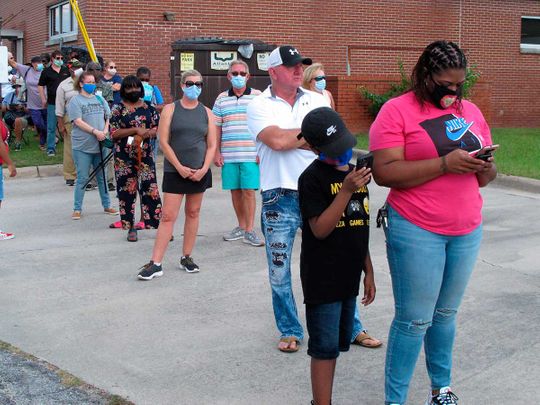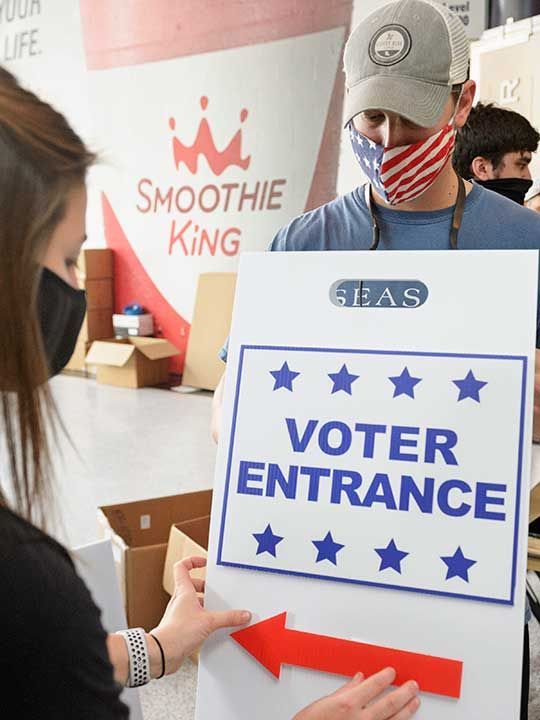
Houston: Haunted by the spectre of a potentially fragile election system, Americans are voting early in unprecedented numbers - a possible harbinger of record turnout for a modern-day election in the US.
With 19 days to go before the Nov. 3 election, about 18.4 million Americans had mailed in ballots or cast votes in person by the end of the day Thursday. If that pace continues, the US will mark a first: More votes cast before Election Day than on it.
In Georgia, some voters waited at polling stations for as long as 11 hours, lining up across parking lots and around strip malls with folding chairs, parasols and coolers. In Vermont, the all-mail-in vote had already reached 35% of the total vote for 2016. And New Jersey, Wisconsin and Virginia voters had cast a quarter of the number of the total ballots submitted in their states four years ago.
“The pace of voting is astounding. It’s truly remarkable,” said Michael McDonald, a University of Florida political science professor and voting expert. The massive advance balloting is effectively “flattening the curve” for elections officials, McDonald said, hopefully allaying fears that a late burst of ballots could complicate tabulations and postpone the outcome of the presidential election. “People are voting. The system is working,” McDonald wrote on Twitter, adding a pointed commentary about President Donald Trump: “It will be difficult to claim the election is fraudulent, although the tweeter-in-chief will try.”

Early vote-by-mail ballots came from registered Democrats in much larger numbers than from registered Republicans. Democrats had returned nearly 4.4 million nationally by Thursday, while Republicans had returned nearly 1.9 million.
Election analysts said the surge could signal greater enthusiasm among Democrats and those determined to force Trump out of office. But Hillary Clinton, the 2016 Democratic presidential nominee, also held an apparent edge in early votes in battleground states, only to see a wave of Trump supporters wash her advantage away on Election Day.
Tom Bonier, CEO of the Democratic voter enhancement firm TargetSmart, said the unprecedented nature of this year’s vote made it impossible to rely on old models. It remains unknown, for instance, how many mail-in votes will be canceled because of problems such as inadequate signatures. “Still, it’s clear that Democrats have a lead now and will go into Election Day with a significant lead,” Bonier said. “But we just don’t know how many Republicans are going to turn up on Election Day. So nobody is just going to sit back and take the next 19 days off.”
The Trump campaign did not return a request for comment. Many of those who crowded early-vote centers expressed fears about trusting their ballot to the U.S. Postal Service. Democrats had heard reports about Republican cutbacks in staffing and vote-sorting machines. Republicans had seen pictures of ballots tossed in the trash. Twenty-three states had opened centres for in-person voting by Thursday.
“It’s scary,” said Michele Jones, a 49-year-old special-education teacher from Grayson, Georgia, who voted this week. “I don’t trust what’s said by the powers that be. ... Could we not be who we are anymore? Could we lose our democracy?” Jones said she voted for Joe Biden in hopes of improving police accountability and the nation’s health care.
Worry about voter fraud
In the Houston suburb of Cypress, Texas, Trump supporter Patricia Skinner, 76, said she worried more about voter fraud than about COVID-19. She wore a mask Wednesday only when she entered her polling place - a German dance hall turned community centre.
Skinner said she voted for Trump in part because she sees Americans losing their liberties because of pandemic shutdowns, including the right to go to church. The sense that the presidential contest is of historic import was one sentiment that crossed party lines.
Gale Barden, who emerged from the polling place after Skinner, said she felt compelled to cast her ballot in person, despite concerns about voters who refused to wear masks. “I needed to do it in person and see that flag go up,” recording her vote, said Barden, 63, who voted for Biden. “This is more important than voting for President Obama, the first Black president. We just can’t risk it. When you don’t trust the system, you have to do what you have to do.”
In the county surrounding Houston, 128,000 people had voted in person Tuesday, nearly double the number who had voted by this time in 2016. Statewide, more than 1.6 million had voted by Thursday, three-quarters of them in person.
Wait for two hours
North Carolina’s early-vote centres opened Thursday and some people waited two hours to cast their ballots. More than half a million already had voted by mail in the battleground state. (More than half of the mail-in voters were Democrats, with the next largest mail-in group being those with no party affiliation.)
Pennsylvania also had a flotilla of votes coming through the mail, with ballots returned by registered Democrats outnumbering those from Republicans by nearly 5 to 1: 393,233 versus 82,468. The votes in several states turned historical norms “topsy-turvy,” with Republicans more prone to vote in person this election, while Democrats have favored voting through the mail, said McDonald, who runs the U.S. Elections Project.
Past elections in many states had shown Republicans as more likely to vote by mail. But Trump appears to be at least partly responsible for reversing that norm, with his repeated and unsubstantiated claims that voting by mail increases the chance of fraud.








